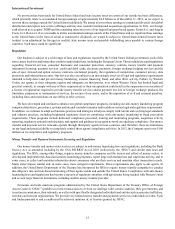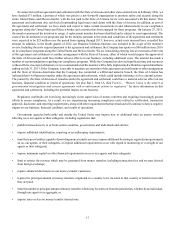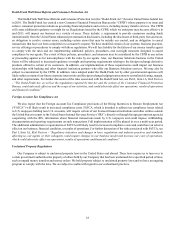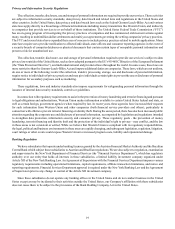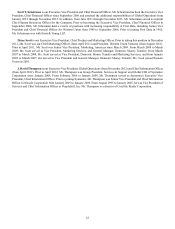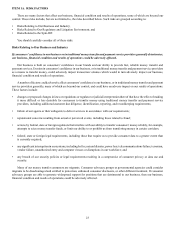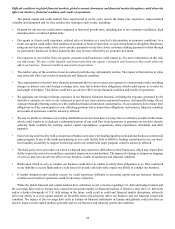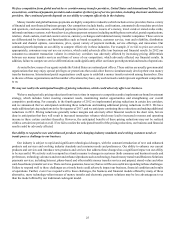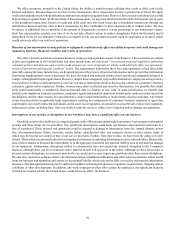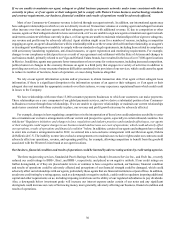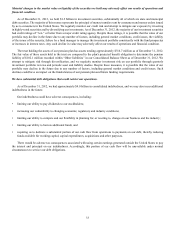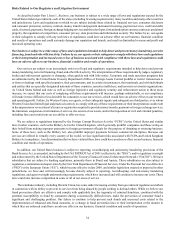Western Union 2012 Annual Report Download - page 30
Download and view the complete annual report
Please find page 30 of the 2012 Western Union annual report below. You can navigate through the pages in the report by either clicking on the pages listed below, or by using the keyword search tool below to find specific information within the annual report.25
We face competition from global and niche or corridor money transfer providers, United States and international banks, card
associations, card-based payments providers and a number of other types of service providers, including electronic and Internet
providers. Our continued growth depends on our ability to compete effectively in the industry.
Money transfer and global business payments are highly competitive industries which include service providers from a variety
of financial and non-financial business groups. Our competitors include banks, credit unions, automated teller machine providers
and operators, card associations, card-based payments providers such as issuers of e-money, travel cards or stored-value cards,
informal remittance systems, web-based services, phone payment systems (including mobile phone networks), postal organizations,
retailers, check cashers, mail and courier services, currency exchanges and traditional money transfer companies. These services
are differentiated by features and functionalities such as brand recognition, customer service, trust and reliability, distribution
network and channel options, convenience, price, speed, variety of payment methods, service offerings, and innovation. Our
continued growth depends on our ability to compete effectively in these industries. For example, if we fail to price our services
appropriately, consumers may not use our services, which could adversely affect our business and financial results. In 2012 our
consumer-to-consumer transaction volume in certain key corridors was adversely affected by increasing pricing differentials
between our money transfer services and those of some of our competitors, which adversely affected our financial results. In
addition, failure to compete on service differentiation could significantly affect our future growth potential and results of operations.
As noted below, many of our agents outside the United States are national post offices. These entities are usually governmental
organizations that may enjoy special privileges or protections that could allow them to simultaneously develop their own money
transfer businesses. International postal organizations could agree to establish a money transfer network among themselves. Due
to the size of these organizations and the number of locations they have, any such network could represent significant competition
to us.
We may not realize the anticipated benefits of pricing reductions, which could adversely affect our business.
We have made periodic pricing reductions from time to time in response to competition and to implement our brand investment
strategy, which includes better meeting consumer needs, maximizing market opportunities and strengthening our overall
competitive positioning. For example, in the fourth quarter of 2012 we implemented pricing reductions in certain key corridors,
and we announced that we anticipated continuing these reductions and making additional pricing reductions in 2013. We have
made additional pricing reductions in the first quarter of 2013, and we anticipate continuing these reductions and making additional
reductions in 2013. Pricing reductions generally reduce margins and adversely affect financial results in the short term, but are
done in anticipation that they will result in increased transaction volumes which may lead to increased revenues and operating
income in these certain corridors thereafter. However, the anticipated benefits of these pricing reductions may not be realized
within a certain time period or at all. If we fail to realize the anticipated benefit of the pricing reductions, our business and financial
results could be adversely affected.
Our ability to respond to new and enhanced products and changing industry standards and evolving customer needs or
trends poses a challenge to our business.
Our industry is subject to rapid and significant technological changes, with the constant introduction of new and enhanced
products and services and evolving industry standards and consumer needs and preferences. Our ability to enhance our current
products and services and introduce new products and services that address these changes has a significant impact on our ability
to be successful. We actively seek to respond in a timely manner to changes in customer (both consumer and business) needs and
preferences, technology advances and new and enhanced products such as technology-based money transfer and Business Solutions
payments services, including Internet, phone-based and other mobile money transfer services and prepaid, stored-value and other
card-based money transfer services. There can be no guarantee, however, that we will be successful in responding to these challenges.
Failure to respond well to these challenges on a timely basis could adversely impact our business, financial condition and results
of operations. Further, even if we respond well to these challenges, the business and financial models offered by many of these
alternative, more technology-reliant means of money transfer and electronic payment solutions may be less advantageous to us
than the model offered by our traditional cash/agent model.


